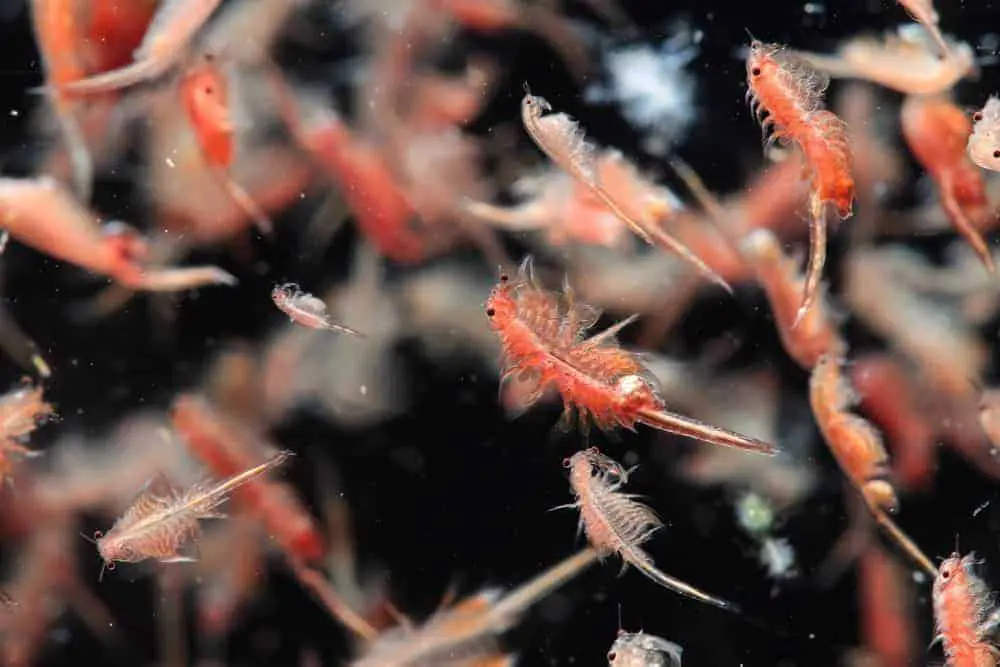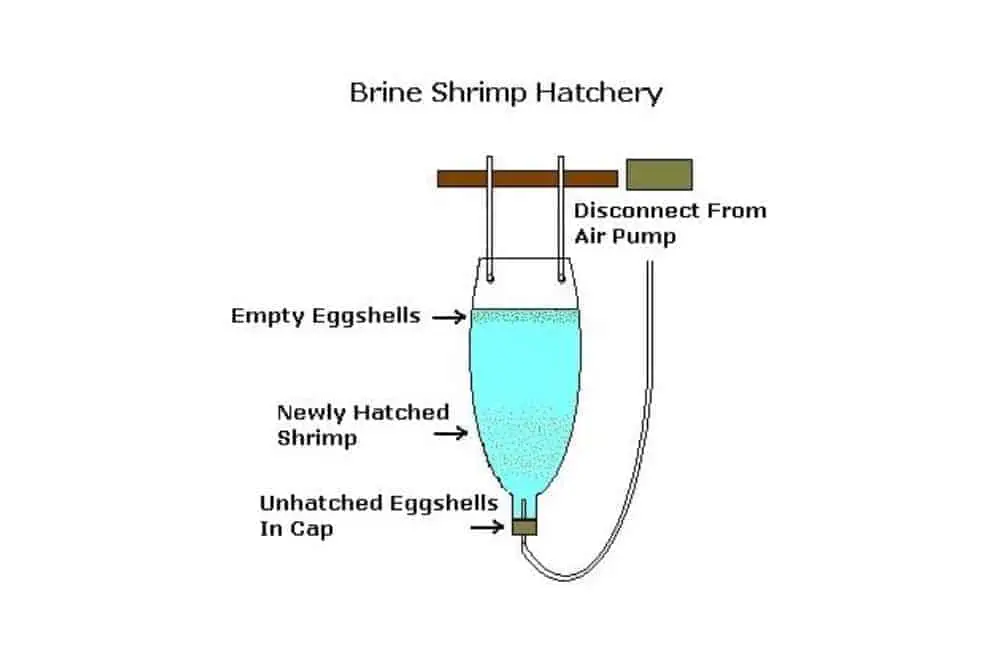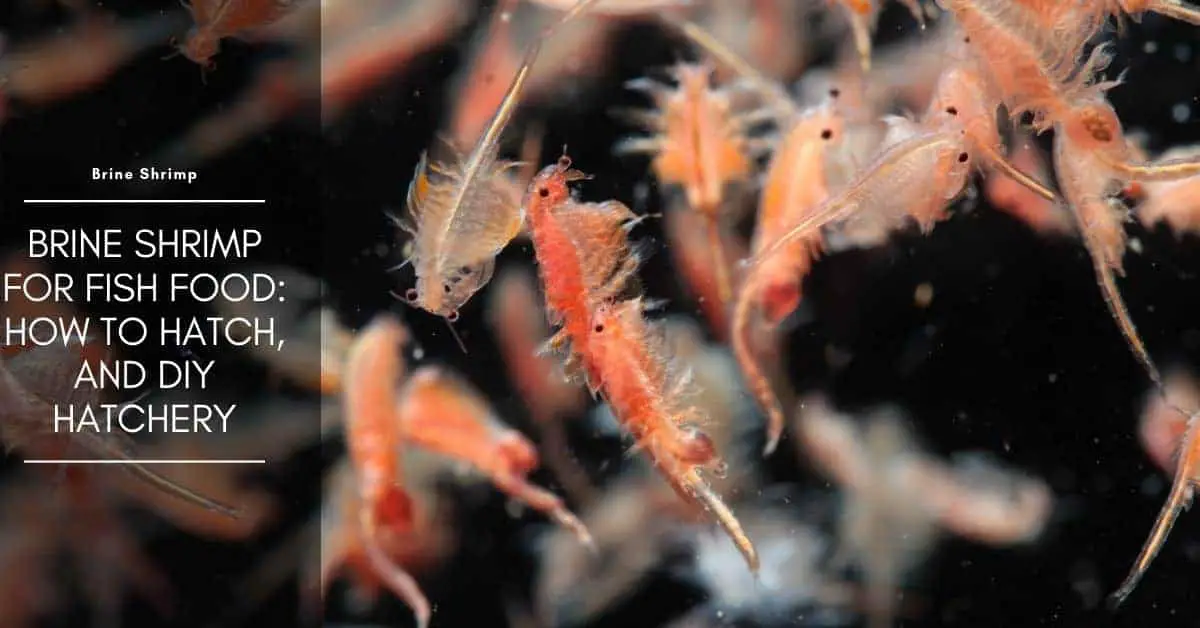Brine shrimp are the live food most commonly used by aquarists. Many pet shops carry live adult brine shrimp. Fish breeders hatch out the eggs (sometimes called cysts) and feed the shrimp nauplii (young hatchling stage) to baby fish and also to small adult fish.
As the name implies, brine shrimp live in bodies of water with very high salt concentrations. There are at least a dozen species in the genus Artemia, and they live on all continents except Antarctica.
The Great Salt Lake in Utah is probably the most well-known source of brine shrimp. Brine Shrimp companies commercially harvest eggs from the Great Salt Lake.
Hatching Brine Shrimp
The main reason for the popularity of brine shrimp is the ability to store their eggs for long periods and hatch them at will. They will stay viable for several years if stored properly. The fish keeper can hatch out the eggs whenever they are needed.
Brine shrimp eggs are available at most pet shops. They usually come in small containers of an ounce (28 g) or less, which is a very uneconomical way to buy them. Even worse are the packages containing both the salt and cysts, where you only need to add water.

Purchasing the eggs in one pound (.45 Kg) cans is the only economical way to go. A pound may last a couple of years for the casual fish breeder and will remain viable for that length of time if kept in the freezer. Buying a can of eggs is a bit of an investment though. A can is expensive. Online sources are usually the best place to buy cans of shrimp eggs. You might be able to get a better price if you buy them by the case. Check with your local fish club to see if they are doing a group buy.
The price of Artemia cysts fluctuate over time depending on harvest conditions, regulations governing their harvest, and demand. If possible, watch the prices and stock up when they are inexpensive.
The eggs are rated by their hatch rates. The best hatch rates are 90%, but lower hatch rates are available at a lower cost. Lower hatch rate eggs may be the most economical option if the price is low enough. Do the math.
API STRESS COAT Aquarium Water Conditioner 16-Ounce Bottle
Tetra AquaSafe Plus, 8.45 Ounces, aquarium Water Conditioner And Dechlorinator, Model Number: 46798162681
$10.19 (as of December 17, 2025 09:07 GMT +03:00 - More infoProduct prices and availability are accurate as of the date/time indicated and are subject to change. Any price and availability information displayed on [relevant Amazon Site(s), as applicable] at the time of purchase will apply to the purchase of this product.)API TAP WATER CONDITIONER Aquarium Water Conditioner 16-Ounce Bottle
$8.48 (as of December 17, 2025 09:07 GMT +03:00 - More infoProduct prices and availability are accurate as of the date/time indicated and are subject to change. Any price and availability information displayed on [relevant Amazon Site(s), as applicable] at the time of purchase will apply to the purchase of this product.)Heat and moisture during storage are the enemies of good hatch rates. Punch a small hole in the can with a large nail. Pour enough shrimp eggs for 5-10 hatches into a small jar with a tight screw top. Put the plastic cover over the can and store both containers in the freezer. Use eggs from the small jar to start your hatches and refill it when it runs out. Doing it this way reduces the number of times the bulk of the eggs get exposed to warm moist air outside of the freezer. That will extend their life.
[amazon bestseller=”brine shrimp hatchery kit” template=”table” items=”3″]
How Long Do Brine Shrimp Live?
The average lifespan is between 1-2 years. The lifespan of your Brine Shrimp depends largely on how well you take care of them. The better you care for your Brine Shrimp, the longer they will live.
What Temperature Should I Keep The Brine Shrimp Hatchery?
The ideal water temperature range for Brine Shrimp is between 70 and 80°F (21 to 26.6°C). You can choose any temperature within this range, as long as you keep it stable. If the temperature falls below 60°F (15.5°C ) or above 80°F (26.6°C) the Brine Shrimp may fall ill and even die so do watch the temperature.
It is worth investing in an aquarium thermometer as they don’t cost much and are extremely useful. If the water is too cold try positioning the hatchery in indirect sunlight or use a lamp to heat the water gently.
DIY Brine Shrimp Hatchery
Setups to hatch brine shrimp are available commercially, but you can also make your own.
One key factor for good hatch rates is to keep the eggs in constant motion in the water. Otherwise, shrimp that do hatch will settle at the bottom and may suffocate before being harvested. Inverted conical containers are best for hatching Artemia eggs.

You can make one out of a 2-liter plastic soda bottle. Cut the bottom off and tightly screw the top on. You will need a stand to hold it inverted. You can make a very nice stand from wood. If you don’t have woodworking skills, you can try carving out a stand from some StyrofoamTM packing material. Or, use your imagination to come up with another way to make a stand! Build 2 or three hatcheries. It takes a day or two for the eggs to hatch and if you want a continuous supply of baby brine shrimp, you will need more than one.
Aeration is needed to keep the eggs and shrimp from sinking to the bottom and dying. Get a plastic or glass tube and slip it into the flexible plastic air tubing from your air pump system.
Put the end down to the bottom of the inverted soda bottle. Adjust the airflow to a slow, steady stream. You will send salt spray around the room if you have it too high.
You can make a cover from the bottom of a soda bottle to prevent salt spray and evaporation. Poke a hole to allow the air tube through. Cut a couple of slits to let it slip over the top of the inverted soda bottle.
Why Can’t I Use Tap Water in My Brine Shrimp Tank?
You can use tap water in your shrimp tank as long as you treat it with a water purifier first. Tap water is treated with a number of chemicals like chlorine which make it safe for a human to drink but can be dangerous for aquatic animals like Brin Shrimp. Treating tap water with water purifiers such as dechlorinating solutions makes it safe for brine shrimp to live in. Alternatively use bottled filtered or distilled water, especially if you have purchased a kit that instructs you to do so.
Will All of My Brine Shrimp Eggs Hatch?
The number of eggs that hatch out of any bunch varies. It is unlikely that all of your eggs will hatch, but even those that don’t can be gathered up and put in a new saltwater solution for a second fry.
What Affects The Hatching Rate of Brine Shrimp?
The number of eggs that hatch and the period of time it takes them to hatch may vary according to a number of different factors. Aeration is incredibly important, as is a proper light source and adequate water salinity and temperature. If all of these conditions are correct, your brine shrimp eggs should hatch within 24-48 hours.
Should I Start Feeding my Brine Shrimp Immediately?
No, for a few days after they hatch your Brine Shrimp will subsist on stored energy from their eggs. You should wait until 5 days after they hatch to start feeding them.
Why Are My Brine Shrimp Gathered at The Surface?
When your Brine Shrimp all gather near the top of the tank, it is often an indication that the oxygen levels in your tank water are too low (they may also turn pinkish in color). To remedy this problem, install an air pump or turn up the speed a little on your air stone (not so high that you can’t see individual bubbles or the Brine Shrimp seem to have trouble swimming).

Hi, my name is Sean, and I’m the primary writer on the site. I’m blogging mostly about freshwater and saltwater aquariums, fish, invertebrates, and plants. I’m experienced in the fishkeeping hobby for many years. Over the years I have kept many tanks, and have recently begun getting more serious in wanting to become a professional aquarist. All my knowledge comes from experience and reading forums and a lot of informative sites. In pursuit of becoming a professional, I also want to inspire as many people as I can to pick up this hobby and keep the public interest growing.
Read more about Sean.
Please join also my Facebook group.




















